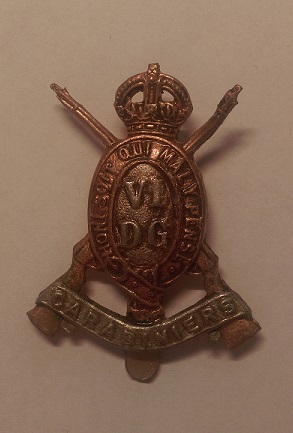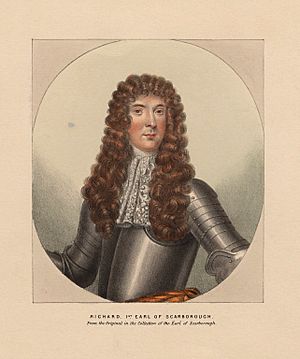Carabiniers (6th Dragoon Guards) facts for kids
Quick facts for kids Carabiniers (6th Dragoon Guards) |
|
|---|---|

Cap badge of the 6th Carabiniers
|
|
| Active | 1685–1922 |
| Country |
|
| Branch | Army |
| Type | Line Cavalry |
| Role | Cavalry |
| Size | One regiment |
| Motto(s) | "Honi Soit Qui Mal Y Pense" Anglo-Norman (Shame upon him who evil thinks) |
| Commanders | |
| Notable commanders |
Henry Leader |
The Carabiniers (6th Dragoon Guards) was a special cavalry group in the British Army. Cavalry units ride horses into battle. This group started way back in 1685 as the Lord Lumley's Regiment of Horse.
Over time, its name changed several times. In 1740, it became His Majesty's 1st Regiment of Carabiniers. Later, in 1756, it was called the 3rd Regiment of Horse (Carabiniers). Finally, in 1788, it became the 6th Regiment of Dragoon Guards.
After serving for over 200 years, including in World War I, this group joined with another one, the 3rd Dragoon Guards (Prince of Wales's), in 1922. Together, they became the 3rd/6th Dragoon Guards.
Contents
A Look at Their History

This cavalry group was first created during the time of King James II. A man named Richard Lumley, 1st Earl of Scarbrough formed it in 1685. He gathered a group of horsemen to help stop a rebellion led by the Duke of Monmouth.
This new group was first known as Lord Lumley's Regiment of Horse. It was ranked as the 9th Regiment of Horse. The Queen Dowager (the King's mother) even allowed them to use the name The Queen Dowager's Horse.
Lumley was later replaced in 1687 because he didn't want Catholic officers in his group. Sir John Talbot took over. After the Glorious Revolution in 1688, Sir George Hewett became the leader.
Fighting in Europe
In 1690, the group became the 8th Regiment of Horse. They were sent to Flanders (part of modern-day Belgium) to fight in the Nine Years' War. In 1692, their name changed again to The King's Regiment of Carabineers.
By 1694, they were the 7th Horse. They fought bravely in big battles during the War of the Spanish Succession. These included the Battle of Blenheim in 1704 and the Battle of Ramillies in 1706.
Changes and More Battles
In 1740, the group was renamed His Majesty's 1st Regiment of Carabiniers. They helped respond to the Jacobite rising of 1745, which was a rebellion in Scotland.
They moved to Ireland in 1746 and were re-ranked as the 3rd Horse. Their name changed again in 1756 to the 3rd Regiment of Horse (Carabiniers). In 1788, they moved back to Britain and became the 6th Regiment of Dragoon Guards. They fought in Flanders again in 1793 during the French Revolutionary Wars.
In 1826, they were called the 6th Regiment of Dragoon Guards (Carabineers). They saw action in the Crimean War during the Siege of Sevastopol. Later, in the late 1870s, they were sent to Afghanistan for the Second Anglo-Afghan War.
Service in South Africa and India
When the Second Boer War started in South Africa, the regiment was sent there in November 1899. They helped in the relief of Kimberley in February 1900. This was an important event where they helped free a besieged city.
After the war ended in 1902, the Carabiniers moved to Bangalore, India. They were part of the Madras Army. In 1906, they took part in a special parade. This parade was for the visit of the Prince and Princess of Wales to Bangalore.
The First World War
When World War I began, the regiment landed in France on August 16, 1914. They were part of the 4th Cavalry Brigade in the 1st Cavalry Division. They served on the Western Front.
They fought in many important battles:
- The Battle of Mons in August 1914.
- The First Battle of the Marne in September 1914.
- The First Battle of Ypres in October 1914.
- The Second Battle of Ypres in April 1915.
- The Battle of the Somme in 1916.
- The Battle of Arras in April 1917.
- The Battle of Cambrai in November 1917.
In October 1922, the regiment joined with the 3rd Dragoon Guards (Prince of Wales's). They formed a new unit called the 3rd/6th Dragoon Guards.
Where to See Their History
You can learn more about the Carabiniers at the Cheshire Military Museum in Chester Castle. Some items are also kept at the Royal Scots Dragoon Guards Museum in Edinburgh Castle.
Battle Honours: Their Achievements
Battle honours are special awards given to military units for their bravery in battles. Here are some of the battles where the Carabiniers fought with distinction:
- Early Wars:
- Blenheim
- Ramillies
- Oudenarde
- Malplaquet
- Warburg
- Willems
- Sevastopol
- Delhi 1857
- Afghanistan 1879-80
- Relief of Kimberley
- Paardeberg
- South Africa 1899-1902
- The Great War (World War I):
- Mons
- Le Cateau
- Retreat from Mons
- Marne 1914
- Aisne 1914
- Messines 1914
- Armentières 1914
- Ypres 1915
- St. Julien
- Bellewaarde
- Arras 1917
- Scarpe 1917
- Cambrai 1917 '18
- Somme 1918
- St. Quentin
- Lys
- Hazebrouck
- Amiens
- Bapaume 1918
- Hindenburg Line
- Canal du Nord
- Selle
- Sambre
- Pursuit to Mons
- France and Flanders 1914–18
Leaders of the Regiment (Colonels)
The "Colonel" was the main leader of the regiment. Here are some of the important people who held this role:
The Queen Dowager's Regiment of Horse (1685)
- 1685 Richard Lumley, 1st Earl of Scarbrough
- 1687 Sir John Talbot
- 1688 Sir George Hewett, 1st Viscount Hewett
- 1689 Richard Beverley
The King's Regiment of Carabineers (1692)
- 1692 Hugh Wyndham
- 1706 Francis Palmes
- 1712 Leigh Backwell
- 1715 Richard Waring
- 1721 Richard Boyle, 2nd Viscount Shannon
- 1727 George MacCartney
- 1730 Henry Scott, 1st Earl of Deloraine
- 1731 Sir Robert Rich, 4th Baronet
- 1733 Charles Cathcart, 8th Lord Cathcart
His Majesty's 1st Regiment of Carabiniers (1740)
- 1740 Phineas Bowles
- 1749 Hon. James Cholmondeley
- 1750 George Germain, 1st Viscount Sackville
3rd Regiment of Horse (Carabiniers) (1756)
- 1757 Louis Dejean
- 1764 Edward Harvey
- 1775 Sir William Augustus Pitt
- 1780 Sir John Irwin
6th Regiment of Dragoon Guards (1788)
- 1788 Henry Lawes Luttrell, 2nd Earl of Carhampton
- 1821 Hon. Robert Taylor
6th Regiment of Dragoon Guards (Carabineers) (1826)
- 1839 Sir Thomas Hawker
- 1858 Sir Alexander Kennedy Clark-Kennedy
- 1860 Sir James Jackson
- 1868 Sir John Rowland Smyth
- 1873 Henry Richmond Jones
- 1880 George Calvert Clarke
- 1891 Charles Sawyer
- 1892 Sir Alexander James Hardy Elliot
- 1902 Sir John Fryer
- 1917 Henry Peregrine Leader
Uniforms and Badges
The Carabiniers had a unique look! Their first uniform included a red coat with green lining. Like other cavalry units, they wore cuirasses (body armor) until 1699.
In 1715, their uniform changed to have pale yellow details. By 1768, they added white lapels (the folded parts of a coat). Officers wore shiny silver epaulettes on their shoulders.
In 1812, they got new leather helmets with "6th Dragoon Guards or Carabiniers" written on them. A big change happened in 1861 when Queen Victoria approved a new uniform. This was because the regiment changed to a "light cavalry" role, meaning they focused more on speed and scouting.
From then until 1914, their main uniform was dark blue with white details. Even though they were called "Dragoon Guards," they were the only dragoon regiment in the British Army to wear dark blue coats instead of the usual red. After 1873, they wore a white feather plume on their brass helmets.
Their special badges, worn on collars and caps from 1900, showed crossed carbines (a type of short rifle) under a crown. Below this was the regiment's name.
See also
- British cavalry during the First World War
- Carabinier


